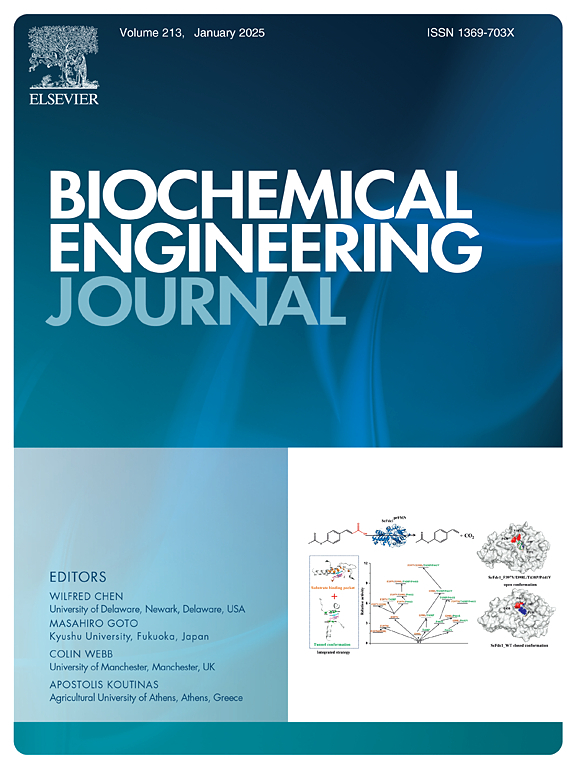A circular economy approach for utilization of tannery fleshing hydrolysate and kitchen wastes into organic fertilizer through enzymatic decomposition
IF 3.7
3区 生物学
Q2 BIOTECHNOLOGY & APPLIED MICROBIOLOGY
引用次数: 0
Abstract
This study presents a sustainable method for converting tannery fleshing waste (FH) into organic fertilizer using enzymatic decomposition with crude protease. After extracting fat from the enzymatic hydrolysis, the enzyme-rich residue was mixed with dried kitchen waste (KW) and allowed to decompose for 45 days, producing nutrient-rich fertilizer. FT-IR spectroscopy confirmed the presence of important functional groups, including hydroxyl, aliphatic hydrocarbons, esters, and amide-I linkages. The organic fertilizers had higher nutrient content, with nitrogen (1.08-1.67%), phosphorus (0.78–0.98 %), potassium (0.1–0.76 %), and magnesium (239–259.5 ppm) which is higher than commercial fertilizers. FESEM-EDX analysis revealed a dense, porous structure with a high surface concentration of calcium, which enhances nutrient release in the soil. Dissolution tests showed that nutrients from the organic fertilizer were released gradually over 36 hours, whereas commercial NPK fertilizers released nutrients within 150 minutes in simulated soil-water conditions. Field trials with a Randomized Complete Block Design (RCBD) demonstrated improved growth in Malabar spinach, particularly with fertilizer sample S-5, which had an optimal flesh to kitchen waste (FH to KW) ratio of 1:10. Although S-5 had a lower nitrogen content (1.08 %), it contained higher levels of phosphorus (0.98 %), potassium (0.765 %), and magnesium (259.5 ppm), contributing to enhanced plant growth. The organic fertilizer resulted in a shoot length of 38.8 ± 2.0 cm, root length of 16.33 cm, 31 ± 3 leaves, and 95.12 % dry matter of the plant. Heavy metal analysis of the plant confirmed that levels of chromium (Cr), iron (Fe), nickel (Ni), cadmium (Cd), copper (Cu), and lead (Pb) were within WHO safety limits. Phytotoxicity tests of the fertilizer also showed no negative impact on Malabar spinach seed germination.
通过酶分解将制革肉水解物和厨房废物利用为有机肥料的循环经济方法
本研究提出了一种可持续的方法,利用粗蛋白酶的酶解作用将制革厂的制革废料(FH)转化为有机肥料。从酶水解中提取脂肪后,富含酶的残留物与干燥的厨余垃圾(KW)混合,并让其分解 45 天,从而产生营养丰富的肥料。傅立叶变换红外光谱证实了重要官能团的存在,包括羟基、脂肪烃、酯和酰胺-I 连接。有机肥的养分含量较高,氮(1.08%-1.67%)、磷(0.78%-0.98%)、钾(0.1%-0.76%)和镁(239-259.5 ppm)的含量均高于商业肥料。FESEM-EDX 分析表明,钙的表面浓度高,结构致密多孔,从而促进了土壤中养分的释放。溶解试验表明,有机肥的养分在 36 小时内逐渐释放,而商业 NPK 肥料在模拟土壤-水条件下 150 分钟内就能释放养分。采用随机完全区组设计(RCBD)进行的田间试验表明,马拉巴尔菠菜的生长情况有所改善,尤其是肥料样品 S-5,它的最佳肥肉与厨余(FH 与 KW)比例为 1:10。虽然 S-5 的氮含量较低(1.08%),但它含有较高水平的磷(0.98%)、钾(0.765%)和镁(259.5 ppm),有助于促进植物生长。施用有机肥后,植物的芽长为(38.8 ± 2.0)厘米,根长为 16.33 厘米,叶片为(31 ± 3)片,干物质含量为 95.12%。对植物的重金属分析表明,铬(Cr)、铁(Fe)、镍(Ni)、镉(Cd)、铜(Cu)和铅(Pb)的含量均在世界卫生组织的安全范围之内。肥料的植物毒性测试也表明,对马拉巴尔菠菜种子的发芽没有负面影响。
本文章由计算机程序翻译,如有差异,请以英文原文为准。
求助全文
约1分钟内获得全文
求助全文
来源期刊

Biochemical Engineering Journal
工程技术-工程:化工
CiteScore
7.10
自引率
5.10%
发文量
380
审稿时长
34 days
期刊介绍:
The Biochemical Engineering Journal aims to promote progress in the crucial chemical engineering aspects of the development of biological processes associated with everything from raw materials preparation to product recovery relevant to industries as diverse as medical/healthcare, industrial biotechnology, and environmental biotechnology.
The Journal welcomes full length original research papers, short communications, and review papers* in the following research fields:
Biocatalysis (enzyme or microbial) and biotransformations, including immobilized biocatalyst preparation and kinetics
Biosensors and Biodevices including biofabrication and novel fuel cell development
Bioseparations including scale-up and protein refolding/renaturation
Environmental Bioengineering including bioconversion, bioremediation, and microbial fuel cells
Bioreactor Systems including characterization, optimization and scale-up
Bioresources and Biorefinery Engineering including biomass conversion, biofuels, bioenergy, and optimization
Industrial Biotechnology including specialty chemicals, platform chemicals and neutraceuticals
Biomaterials and Tissue Engineering including bioartificial organs, cell encapsulation, and controlled release
Cell Culture Engineering (plant, animal or insect cells) including viral vectors, monoclonal antibodies, recombinant proteins, vaccines, and secondary metabolites
Cell Therapies and Stem Cells including pluripotent, mesenchymal and hematopoietic stem cells; immunotherapies; tissue-specific differentiation; and cryopreservation
Metabolic Engineering, Systems and Synthetic Biology including OMICS, bioinformatics, in silico biology, and metabolic flux analysis
Protein Engineering including enzyme engineering and directed evolution.
 求助内容:
求助内容: 应助结果提醒方式:
应助结果提醒方式:


